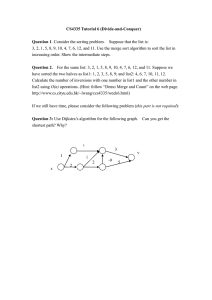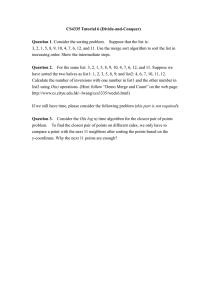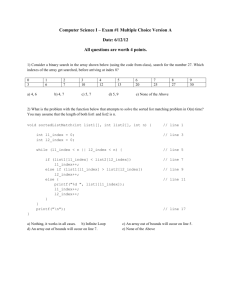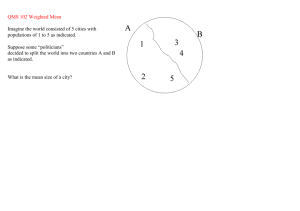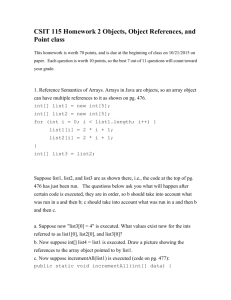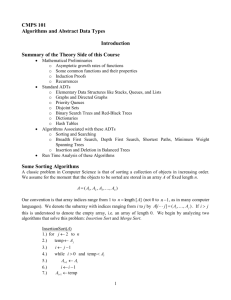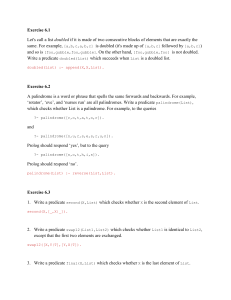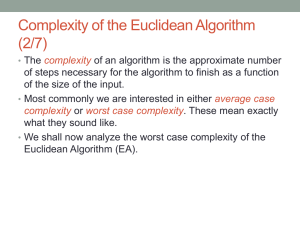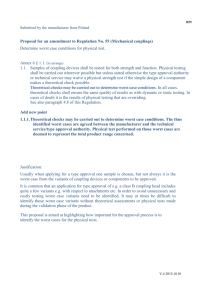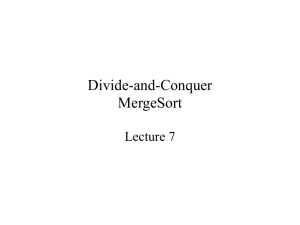Quiz2
advertisement
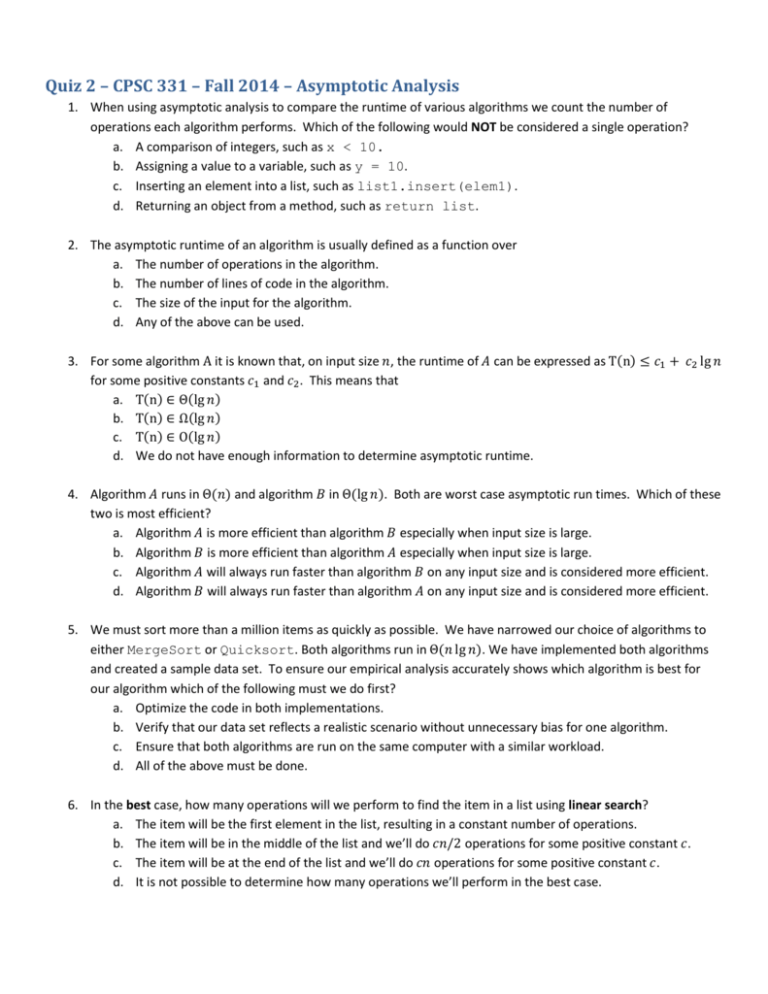
Quiz 2 – CPSC 331 – Fall 2014 – Asymptotic Analysis
1. When using asymptotic analysis to compare the runtime of various algorithms we count the number of
operations each algorithm performs. Which of the following would NOT be considered a single operation?
a. A comparison of integers, such as x < 10.
b. Assigning a value to a variable, such as y = 10.
c. Inserting an element into a list, such as list1.insert(elem1).
d. Returning an object from a method, such as return list.
2. The asymptotic runtime of an algorithm is usually defined as a function over
a. The number of operations in the algorithm.
b. The number of lines of code in the algorithm.
c. The size of the input for the algorithm.
d. Any of the above can be used.
3. For some algorithm A it is known that, on input size 𝑛, the runtime of 𝐴 can be expressed as T(n) ≤ 𝑐1 + 𝑐2 lg 𝑛
for some positive constants 𝑐1 and 𝑐2 . This means that
a. T(n) ∈ Θ(lg 𝑛)
b. T(n) ∈ Ω(lg 𝑛)
c. T(n) ∈ O(lg 𝑛)
d. We do not have enough information to determine asymptotic runtime.
4. Algorithm 𝐴 runs in Θ(𝑛) and algorithm 𝐵 in Θ(lg 𝑛). Both are worst case asymptotic run times. Which of these
two is most efficient?
a. Algorithm 𝐴 is more efficient than algorithm 𝐵 especially when input size is large.
b. Algorithm 𝐵 is more efficient than algorithm 𝐴 especially when input size is large.
c. Algorithm 𝐴 will always run faster than algorithm 𝐵 on any input size and is considered more efficient.
d. Algorithm 𝐵 will always run faster than algorithm 𝐴 on any input size and is considered more efficient.
5. We must sort more than a million items as quickly as possible. We have narrowed our choice of algorithms to
either MergeSort or Quicksort. Both algorithms run in Θ(𝑛 lg 𝑛). We have implemented both algorithms
and created a sample data set. To ensure our empirical analysis accurately shows which algorithm is best for
our algorithm which of the following must we do first?
a. Optimize the code in both implementations.
b. Verify that our data set reflects a realistic scenario without unnecessary bias for one algorithm.
c. Ensure that both algorithms are run on the same computer with a similar workload.
d. All of the above must be done.
6. In the best case, how many operations will we perform to find the item in a list using linear search?
a. The item will be the first element in the list, resulting in a constant number of operations.
b. The item will be in the middle of the list and we’ll do 𝑐𝑛/2 operations for some positive constant 𝑐.
c. The item will be at the end of the list and we’ll do 𝑐𝑛 operations for some positive constant 𝑐.
d. It is not possible to determine how many operations we’ll perform in the best case.
7. In the in the worst case, how many operations will we perform to find the item in a list using binary search?
a. The item will be the last one we consider. Since we cut the list to consider in half after each item
considered this will take at worst 𝑐 lg 𝑛 operations for some positive constant 𝑐.
b. The item will be the first one we consider and we’ll do a constant number of operations.
c. The item will be at the end of the list and we’ll do 𝑐𝑛 operations for some positive constant 𝑐.
d. It is not possible to determine how many operations we’ll perform in this case.
8. Consider the code for function sum below and let 𝑐1 and 𝑐2 be positive constants. Which is the best expression
of the worst case runtime of sum?
public int sum(int n) {
int sum = 0;
for (int i = 1; i <= n; i++) {
sum = sum + i;
}
return sum;
}
a. ∑𝑛𝑖=1 1
b. 𝑐1 𝑛
c. 𝑐1 + ∑𝑛𝑖=1 𝑐2
d. 𝑐1 + ∑𝑛𝑖=1 ∑𝑖𝑗=1 𝑐2
9. Which best expresses the worst case asymptotic runtime of the function sum from the previous question?
a. Θ(lg 𝑛)
b. Θ(𝑛)
c. Θ(𝑛2 )
d. Θ(n lg 𝑛)
10. Consider again the algorithm for MergeSort.
public Element[] mergeSort(Element[] list) {
if (list.length <= 1) return list;
int mid = list.length/2;
Element[] list1 = new Element[mid];
System.arraycopy(list, 0, list1, 0, mid);
list1 = mergeSort(list1);
Element[] list2 = new Element[list.length - mid];
System.arraycopy(list, mid, list2, 0, list2.length);
list2 = mergeSort(list2);
return (merge(list1, list2));
}
Assume that arraycopy and merge each run in (n) in the worst case. Which of the following recurrence
relations best describes the worst case runtime of MergeSort?
a. 𝑇(𝑛) = 𝑇(𝑛⁄2) + 1 for 𝑛 > 1.
b. 𝑇(𝑛) = 2𝑇(𝑛⁄2) + 1 for 𝑛 > 1.
c. 𝑇(𝑛) = 2𝑇(𝑛⁄2) + 𝑐𝑛 lg 𝑛 for 𝑛 > 1 and some positive constant 𝑐.
d. 𝑇(𝑛) = 2𝑇(𝑛⁄2) + 𝑐𝑛 for 𝑛 > 1 and some positive constant 𝑐.
